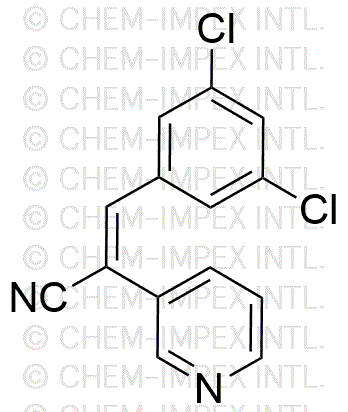Tyrphostin RG 14620 is widely utilized in research focused on:
- Cancer Research: This compound is known for its ability to inhibit specific tyrosine kinases, making it a valuable tool in studying cancer cell signaling pathways and potential treatments.
- Neuroscience: Researchers use it to explore the role of tyrosine kinases in neuronal signaling, which can lead to advancements in understanding neurodegenerative diseases.
- Drug Development: Its properties allow scientists to develop targeted therapies that can minimize side effects compared to traditional chemotherapy, enhancing patient outcomes.
- Cell Biology: It serves as a critical reagent in experiments designed to dissect cellular processes, particularly those involving growth factor signaling.
- Pharmaceutical Formulations: The compound's unique structure can be leveraged in creating innovative drug formulations, potentially improving bioavailability and efficacy.
General Information
Properties
Safety and Regulations
Applications
Tyrphostin RG 14620 is widely utilized in research focused on:
- Cancer Research: This compound is known for its ability to inhibit specific tyrosine kinases, making it a valuable tool in studying cancer cell signaling pathways and potential treatments.
- Neuroscience: Researchers use it to explore the role of tyrosine kinases in neuronal signaling, which can lead to advancements in understanding neurodegenerative diseases.
- Drug Development: Its properties allow scientists to develop targeted therapies that can minimize side effects compared to traditional chemotherapy, enhancing patient outcomes.
- Cell Biology: It serves as a critical reagent in experiments designed to dissect cellular processes, particularly those involving growth factor signaling.
- Pharmaceutical Formulations: The compound's unique structure can be leveraged in creating innovative drug formulations, potentially improving bioavailability and efficacy.
Documents
Safety Data Sheets (SDS)
The SDS provides comprehensive safety information on handling, storage, and disposal of the product.
Product Specification (PS)
The PS provides a comprehensive breakdown of the product’s properties, including chemical composition, physical state, purity, and storage requirements. It also details acceptable quality ranges and the product's intended applications.
Certificates of Analysis (COA)
Search for Certificates of Analysis (COA) by entering the products Lot Number. Lot and Batch Numbers can be found on a product’s label following the words ‘Lot’ or ‘Batch’.
*Catalog Number
*Lot Number
Certificates Of Origin (COO)
This COO confirms the country where the product was manufactured, and also details the materials and components used in it and whether it is derived from natural, synthetic, or other specific sources. This certificate may be required for customs, trade, and regulatory compliance.
*Catalog Number
*Lot Number
Safety Data Sheets (SDS)
The SDS provides comprehensive safety information on handling, storage, and disposal of the product.
DownloadProduct Specification (PS)
The PS provides a comprehensive breakdown of the product’s properties, including chemical composition, physical state, purity, and storage requirements. It also details acceptable quality ranges and the product's intended applications.
DownloadCertificates of Analysis (COA)
Search for Certificates of Analysis (COA) by entering the products Lot Number. Lot and Batch Numbers can be found on a product’s label following the words ‘Lot’ or ‘Batch’.
*Catalog Number
*Lot Number
Certificates Of Origin (COO)
This COO confirms the country where the product was manufactured, and also details the materials and components used in it and whether it is derived from natural, synthetic, or other specific sources. This certificate may be required for customs, trade, and regulatory compliance.


